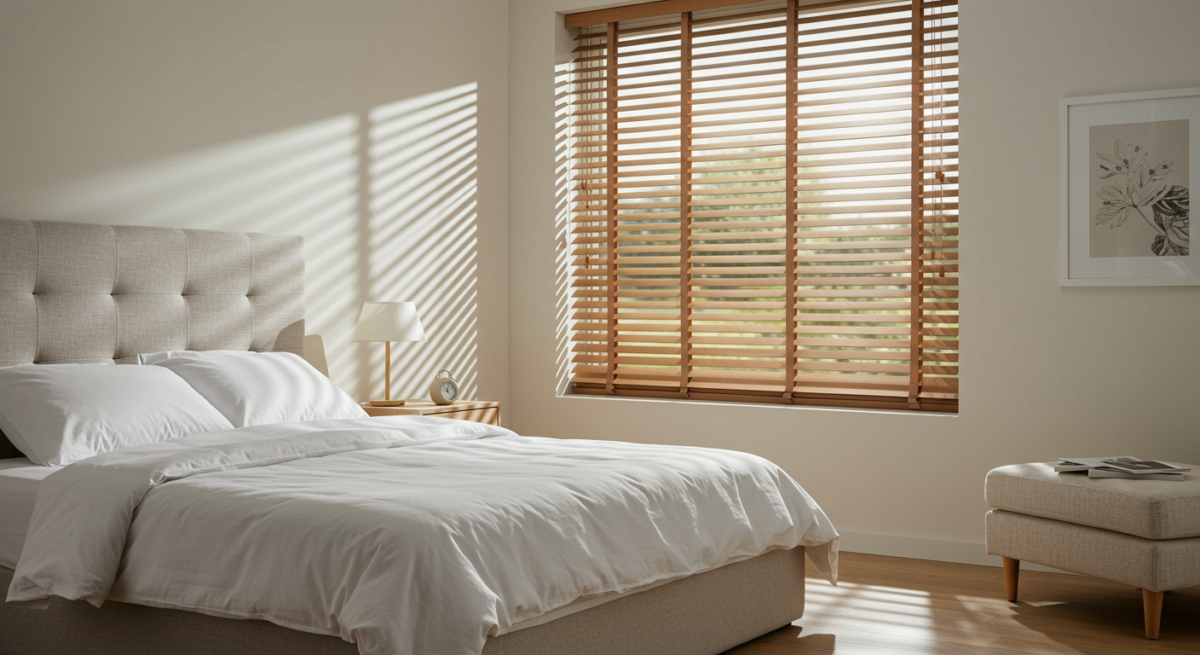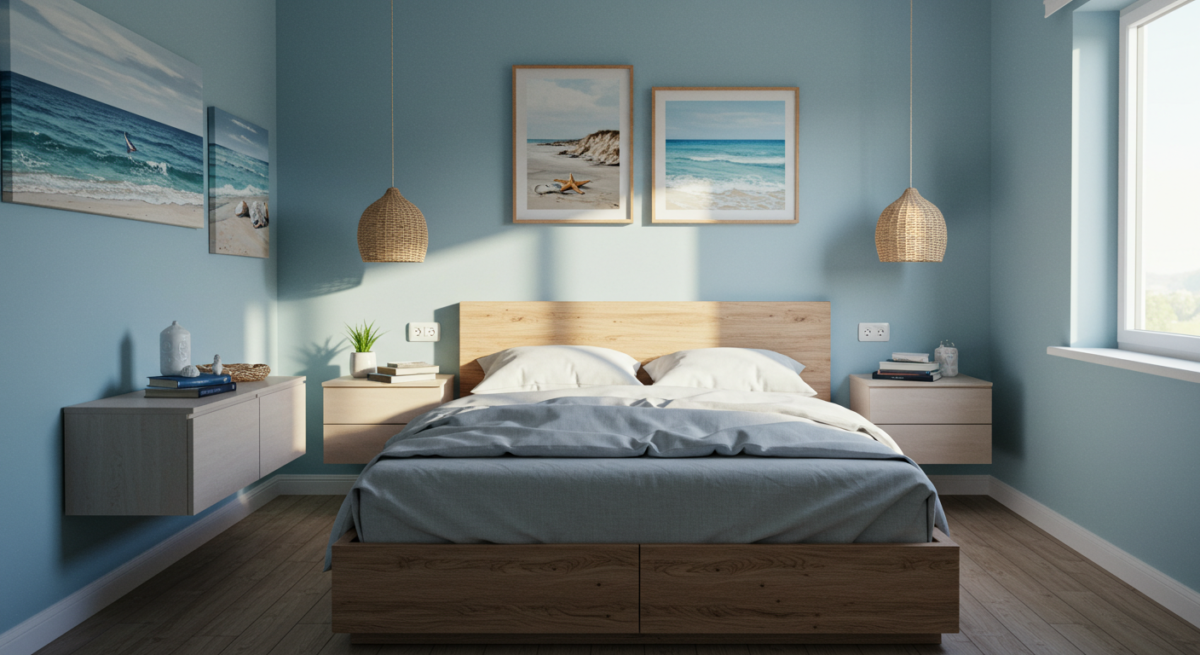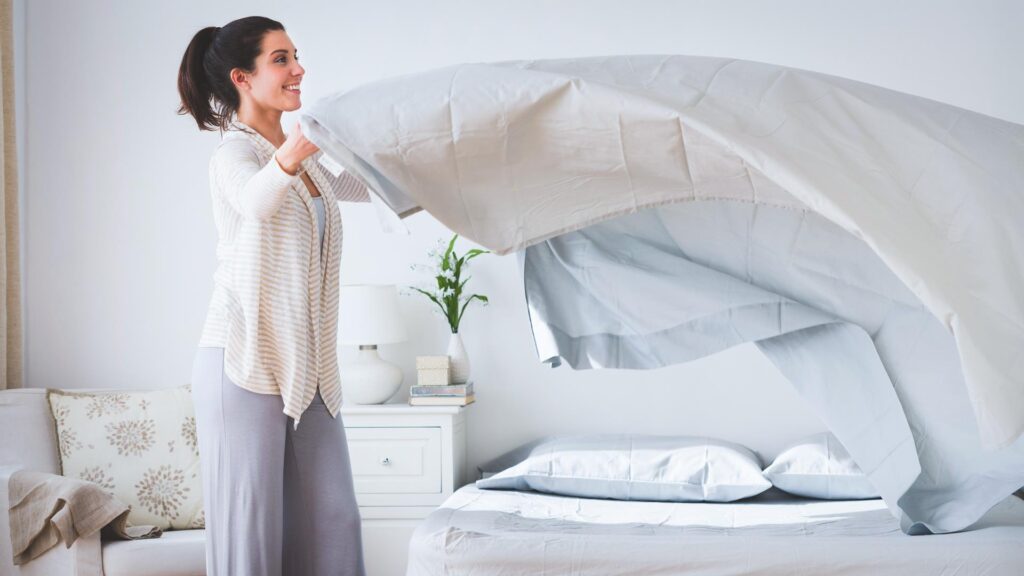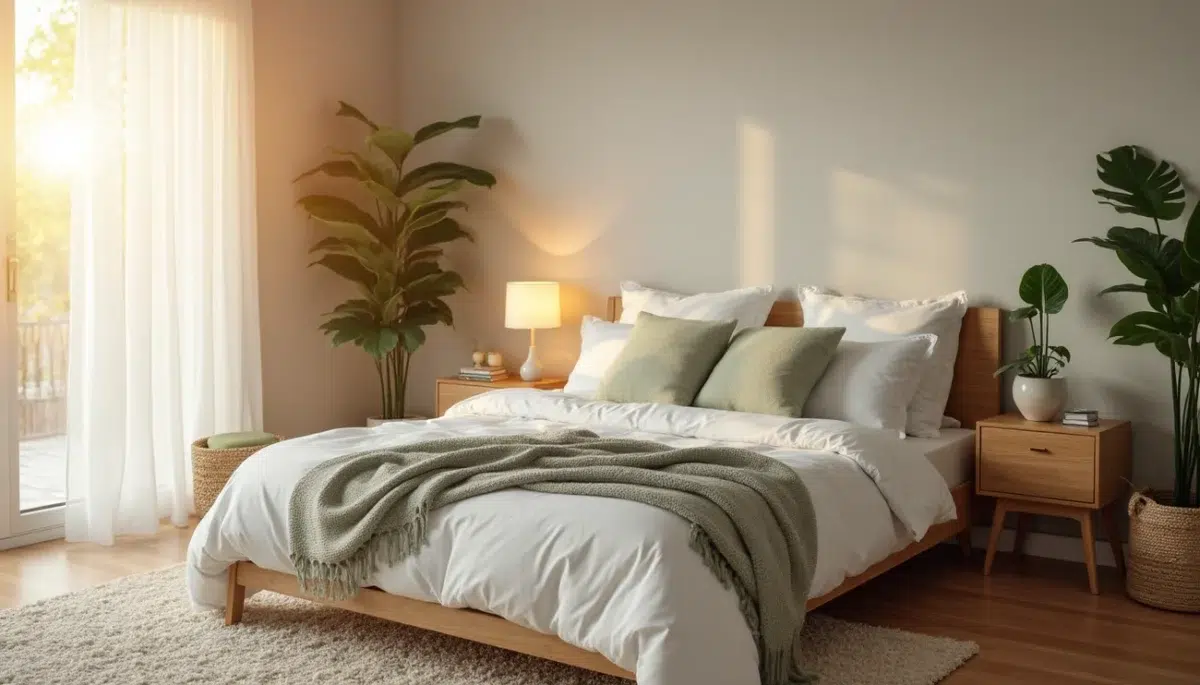Sleep Talk Blog, Health & Wellbeing
Why Your Calming Bedroom Design Could Be the Key to Better Mental Health
Table of Contents
Think about it – you spend nearly a third of your life asleep, and a huge chunk of your home time tucked away in your bedroom. This makes a calming bedroom design far more than just a nice-to-have. It's actually essential for keeping your mental health in check.
Here's what's fascinating: environmental psychology studies have proven there's a real connection between how your space looks and how you feel. A messy, chaotic room? That leads to a messy, chaotic mind – ramping up your stress and anxiety levels. But flip that around with a clean, organised space, and you'll start feeling calm and genuinely relaxed.
What's even better is that bringing bits of the natural world into your bedroom works wonders for both your mental and physical wellbeing. Whether that's calming bedroom design ideas that make the most of natural light to lift your energy and mood, or calming green bedroom designs that bring that gorgeous outdoors feeling inside – the possibilities for creating your perfect peaceful retreat are endless.
So, what will you discover in this guide? Why your bedroom matters way more than you might realise, which design tricks actually work to create tranquillity, and how a good clear-out can give you serious mental clarity. Plus, you'll get loads of practical calming bedroom design tips to turn any sleeping space into your own personal haven for rest and restoration.
The link between your bedroom and mental wellbeing
Your bedroom is so much more than just a place to sleep. It's your personal sanctuary where you retreat to gather your thoughts and recharge your mental batteries. Understanding this deeper connection between your sleeping space and psychological wellbeing shows exactly why thoughtful bedroom design matters far more than just looking good.
Why the bedroom matters more than we think
Your bedroom environment directly influences sleep quality, which affects countless aspects of your mental and physical health. Poor sleep connects to serious health conditions including heart disease and high blood pressure. What's particularly interesting is that studies show people who maintain a tidy bedroom are far more likely to report getting the rest they need.
The Mental Health Foundation puts it perfectly: sleep is as vital to our bodies as eating, drinking and breathing—essential for maintaining good mental and physical health. This makes your bedroom a foundational element in your overall wellbeing, not just a place to rest your head.
How your environment shapes your mood
Room design impacts emotions in surprisingly powerful ways. Studies show that rectangular room geometry can increase negative mood, while curved spaces enhance positive feelings and lower physiological arousal. Clutter and disorganisation impair information processing and negatively affect your wellbeing.
The arrangement of furniture and flow of space directly influences your emotional state. Open layouts with ample natural light promote calmness and reduce anxiety, whilst cramped, cluttered spaces create feelings of tension. Worth noting: exposure to artificial light in the evening can delay circadian rhythms, making it take longer to fall asleep.

The role of environmental psychology
Environmental psychology examines the relationship between people and their surroundings, studying how physical environments influence behaviour, perceptions and emotional states. This field reveals that the condition of our immediate surroundings significantly affects our mood and stress levels.
Research in environmental psychology has identified several elements that contribute to a calming bedroom design:
- Colour psychology - Soft blues, greens and earth tones soothe the mind in preparation for sleep
- Layout principles - Bed placement away from the door but where the door remains visible creates subliminal reassurance
- Sensory elements - Certain scents like lavender have been proven to improve sleep quality
Creating a calming bedroom design isn't just about making things look pretty—it's about applying evidence-based principles to craft an environment that actively supports mental restoration and peace.
What makes a bedroom truly calming?
Creating a tranquil bedroom isn't just about making it look pretty – it's about choosing elements that genuinely help you relax and feel mentally at ease. The perfect combination of colours, lighting, layout, and textures will naturally calm your mind and get your body ready for proper rest.
Which colours will help you sleep better?
The colours you surround yourself with have a massive impact on how you feel and how well you sleep. Research shows that cool colours with shorter wavelengths, especially blues and greens, help you relax and make you feel "safe" and "secure". House of Fraser has even seen sales jump by 74% for calming colours. Here's what to go for:
- Soft blues and greens – these can actually lower your heart rate and blood pressure
- Earthy tones like sandy taupe, soft beige, and gentle terracotta to add warmth
- Muted neutrals that instantly create a sense of stillness

Don't overlook darker shades either – deep blues create that lovely cocooning effect, soaking up light and making everything feel cosier.
Getting your lighting just right
Natural light is absolutely crucial for keeping your mood stable and your sleep cycle on track. The light quality changes depending on which way your room faces – north-facing rooms get harsh, cold light whilst south-facing rooms enjoy lovely warm light all day long. Once the sun goes down, switch to low-wattage bulbs with soft, yellow or red tones to keep your circadian rhythm happy. Position your lights to create gentle pools of light rather than harsh brightness everywhere.
Why your bedroom layout matters
How you arrange your bedroom furniture genuinely affects how relaxed you feel. Following feng shui wisdom, position your bed away from the door (but keep the door visible) and avoid putting it under windows or sloped ceilings. This gives you that subconscious sense of security and better energy flow. Keep things clutter-free too – studies prove that busy, complicated spaces overexcite your brain.
Textures that make you feel at home
Natural materials have special qualities that help you unwind. Try these:
- Breathable fabrics like linen and organic cotton for your bedding
- Wooden furniture that brings warmth and natural beauty
- Different textures through velvet cushions, woven throws, or bouclé accents
These materials work together to create a space that feels genuinely comforting whilst actively supporting your mental wellbeing.
Clear the clutter, clear your mind
Here's something that might surprise you: recent research shows a massive connection between physical clutter and mental wellbeing. Your bedroom's organisation isn't just about looking tidy—it genuinely affects how you feel and can either boost or damage your mental health.
What clutter does to your stress levels
Living surrounded by mess cranks up cortisol—your main stress hormone—all day long. Women seem to feel this effect even more, often getting seriously stressed when there's clutter everywhere. But it goes deeper than just feeling frazzled. Bedroom clutter has been linked to lower life satisfaction, fuzzy thinking, and struggling to focus on what matters.
Even more worrying? Too much clutter connects to depression and anxiety. It creates this awful cycle—feeling down makes tackling the mess harder, which then makes you feel worse.
Storage tricks that actually work
Smart bedroom storage can turn chaos into calm sanctuary for mental clarity. Here are some game-changing ideas:
- Give everything a proper "home" so you stop wasting mental energy on decisions
- Under-bed storage or ottoman beds to squeeze out every bit of space
- Drawer dividers to keep small bits organised
- Bedside tables with built-in storage for your nighttime essentials
Takeaway Tip: Start with a proper clear-out before buying any storage solutions. You'll find organising much easier when there's less stuff to deal with.
Making space for your mind to breathe
A clutter-free bedroom gives both your space and your brain room to relax. When your surfaces stay clear and everything has its place, your mind can switch off instead of constantly trying to process all that visual noise. Think about it—everything you own takes up some of your time, energy and headspace. Get rid of the unnecessary bits and you free up those mental resources.
Keep things simple with the "one in, one out" rule—every time something new comes in, something else goes out. Don't forget a quick five-minute tidy before bed stops things piling up and gets you into good habits.

Your bedroom transformation isn't just about creating a prettier space—you're actively supporting your mental wellbeing with thoughtful calming bedroom design.
Make it personal: bringing nature and character into your bedroom
There's something special about connecting with nature – it's called biophilia, and it's this deep-rooted need we all have for the natural world. When you bring elements of nature into your bedroom design, you're not just making it look pretty. You're actually tapping into something that genuinely supports your mental wellbeing.
Why calming green bedroom designs work so well

Biophilic design is all about bringing the outdoors inside, creating that lovely sense of harmony and calm. This isn't just trendy design talk – it's rooted in our natural need to connect with nature, helping reduce stress and boost your overall health.
Calming green bedroom designs are brilliant for this. Green shades naturally make you feel tranquil, whether you go for soft sage or deep forest tones. Green bedrooms really do create the ultimate oasis, bringing all that outdoor relaxation right into your space. Light greens turn your bedroom into a refreshing haven, whilst those deeper greens add sophistication and elegance.
The right plants can work wonders for your sleep
Indoor plants do so much more than just look good. NASA's Clean Air Study found that certain houseplants can remove up to 87% of air toxins in just 24 hours. Plus, plants help lower your blood pressure and keep you calm by working on your nervous system.
Here are your best bedroom plant options:
- Snake plants – these clever plants release oxygen all night long, so you'll wake up feeling properly refreshed
- Peace lilies – brilliant for air quality as they absorb mould spores
- Lavender – that gorgeous soothing scent helps you relax and sleep better
- Aloe vera – produces oxygen at night and has healing properties too
Personal touches that create your sanctuary
Don't forget – whilst bringing nature in matters, making your bedroom truly personal creates that essential sense of sanctuary. Your bedroom should be your personal refuge, somewhere that genuinely improves your mood, reduces stress, and helps you sleep properly. Rather than following strict design rules, focus on what makes you feel peaceful and comfortable.
Choose artwork featuring calming natural scenes, especially in those serene colour palettes of greens, blues and neutrals – it makes both going to sleep and waking up so much more pleasant. And when you add materials like wooden furniture or stone accents, you're creating a real physical connection to the outdoors that enhances your wellbeing.

Your bedroom transformation starts now
So there you have it – your bedroom really is far more than just a place to crash at the end of the day.
The research couldn't be clearer: thoughtful bedroom design genuinely impacts how well you sleep, how stressed you feel, and your overall mental health. Whether it's those calming blues and greens that actually slow your heart rate, or simply clearing away clutter to stop your cortisol levels spiking – these aren't just nice ideas, they're scientifically backed solutions.
Here's the brilliant part: you don't need to overhaul everything at once. A few well-chosen plants, tweaking your lighting, or even just a proper clear-out can completely transform how your space feels. Remember, you're creating your own personal sanctuary here, so trust your instincts about what makes you feel peaceful and comfortable.
Think about it – you spend nearly a third of your life sleeping, which makes your bedroom arguably the most important room for supporting your mental wellbeing. Don't treat it as an afterthought when it could be your secret weapon for better mental health.

Your perfect bedroom will look different from everyone else's, and that's exactly how it should be. But the principles we've covered – from colour choices to organisation tricks to bringing nature indoors – give you a solid starting point for creating a space that genuinely helps you unwind and recharge.
The best news? These changes don't have to cost a fortune or take forever to put into practice. Sometimes the smallest adjustments to your personal environment create the biggest ripples throughout your entire life – improving everything from your mood to how productive you feel.
Are you struggling with sleep or stress? Your bedroom makeover might just be the solution you've been overlooking. After all, the journey to better mental health often starts right at home – in the room where each day ends and begins.
FAQs
Q1. How can bedroom design impact mental health? A well-designed bedroom can significantly improve mental health by reducing stress, promoting better sleep, and creating a sense of calm. Elements such as calming colours, proper lighting, and organised spaces can contribute to a more relaxed state of mind and improved overall wellbeing.
Q2. What are some key elements of a calming bedroom design? Key elements include soothing colour schemes (like soft blues and greens), proper lighting (both natural and artificial), a clutter-free environment, comfortable textures, and the incorporation of natural elements. These features work together to create a peaceful atmosphere conducive to relaxation and good sleep.
Q3. How does clutter in the bedroom affect stress levels? Clutter in the bedroom can significantly increase stress levels by raising cortisol (the stress hormone) throughout the day. It can also lead to lower life satisfaction, poorer working memory, and difficulty focusing on important tasks. Maintaining an organised bedroom is crucial for mental clarity and reduced stress.
Q4. Can plants in the bedroom improve sleep and mood? Yes, certain plants can improve both sleep quality and mood. Some plants, like snake plants and aloe vera, release oxygen at night, helping you wake up feeling more refreshed. Others, such as lavender, provide soothing scents that aid relaxation. Plants also help purify the air, creating a healthier sleeping environment.
Q5. How can personalising a bedroom contribute to better mental health? Personalising your bedroom creates a sense of safety and comfort, which is essential for good mental health. Adding personal touches like meaningful artwork, favourite colours, or cherished objects can make the space feel like a true sanctuary. This feeling of security and comfort can lead to reduced stress levels and improved overall wellbeing.


